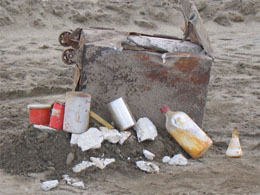On February 27, 1989, Washington Governor Booth Gardner (1936-2013) announces the Tri-Party Agreement between the state and two federal agencies, the Environmental Protection Agency and the Department of Energy, on a framework for cleaning up radioactive and toxic waste at the Hanford Reservation near Richland. The site, which has been used for production of plutonium since the 1940s, is heavily contaminated. The original Tri-Party Agreement projects completion in 30 years, but by 2012 the Department of Energy will estimate that the work will not be completed until 2065, and at much higher cost than originally estimated.
A Historic Agreement
The 1989 Tri-Party Agreement established a 30-year timetable for the cleanup and a framework for determining the work required. Governor Gardner called it "historic" and "probably the best of any in the country" (Schneider). But it was controversial for several reasons.
Some sectors were put off by the very idea of devoting federal funds to the cleanup. W. Henson Moore (b. 1939), deputy secretary of energy at the time, recalled in 2009, "It was a culture change and we were pounded by people within the Defense Department. We were pounded by people within the Department of Energy. We were pounded by contractors, who were essentially resisting this change from production to cleanup. ... We were being pushed on all fronts. Because quite frankly, a culture had been developed in building the nuclear weapons for the nation’s defense. And that came first. It came first before everything else. The environment wasn’t even a consideration. Health and safety was less of a consideration. The consideration was succeed at all cost. The nation’s defense depended upon it" (Oregon, p. vi).
The agreement drew criticism from those who felt it didn't go far enough. Critics noted that the Tri-Party Agreement did not even estimate expected costs, though it did call for the federal government to spend $560 million annually over the next five years.
On January 4, the Department of Energy had released a report that estimated that cleanup and maintenance costs at Hanford could reach $45 billion. That report drew criticism from Senator John Glenn (1921-2016), D-Ohio, who said the department had a history of underestimating costs (Shenon).
Critics also note that the scope of the work to be done was not well understood and that, accordingly, costs could mushroom. "At the time the Tri-Party Agreement was initially negotiated, the toughest negotiations were over what could be done and would be done about the tank wastes. The uncertainties about what was in the tanks, how to sample them to better understand their contents, and how to develop feasible processes to remove and treat the wastes were enormous," Randy Smith, former Tri-Party Agreement negotiator for EPA, recalled in 2009. "The initial Tri-Party Agreement was quite sketchy about the details of what ought to be done" (Oregon, p. ix).
Others criticized the agreement as not being easily enforceable. Environmentalists and state officials had argued that the agreement should be in the form of a consent decree that could be enforced by the courts. ''We wanted a consent decree because if there is a problem it's easier to solve,'' Jay Manning, a Washington assistant attorney general and its principal negotiator, tells a reporter on the day of the agreement announcement. "'The Energy Department basically said if we want a consent decree, we might get one ultimately. But it was going take a war before we won'' (Schneider).
Challenges and Problems
In fact, the effort to clean up Hanford faced ongoing challenges and, by 2014, was still far from complete.
A study commissioned by the Senate Energy and Natural Resources Commission in 1995 found that most of the $7.5 billion spent by that time had had little impact. "Hanford is floundering in a legal and regulatory morass," the study says. "For its part, DOE has been less and less able to prevent the large number of state and federal agencies and `stakeholder' groups with an interest in the site from laying claim to significant portions of the Hanford budget ... ." (Nelson).
In 2008, Washington filed suit against the federal government to force cleanup action. In 2010, a U.S. District Court approved a new cleanup schedule that did not project completion of the project until 2052. In 2012, the Department of Energy estimated the cost or remaining cleanup work at Hanford -- at the time projected to be finished in 2065 -- at $112 billion.
"In my younger, naïve days I dreamed that Hanford cleanup would be two-thirds done by 2009," Bill Dixon, former administrator of nuclear safety and energy facilities for the Oregon Department of Energy, recalled in 2009. "The Columbia River shore would be clean, most of the plutonium-contaminated waste would have been disposed, and tank waste treatment would have been ongoing for over 10 years. Now older and wiser, I look back on 20 years of struggles and feel proud of the progress that has been made and optimistic that our nation will complete this vital cleanup mission ... . When Hanford cleanup is done is less important than it is done” (Oregon, p. xi).

